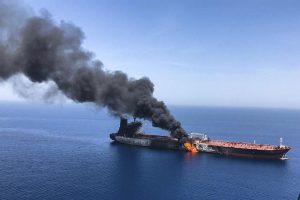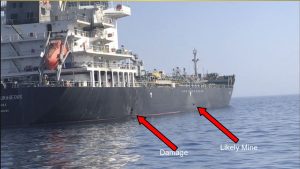- Author
- Editorial Staff
- Subjects
- History - general
- Tags
-
- RAN Ships
- None noted.
- Publication
- September 2019 edition of the Naval Historical Review (all rights reserved)
The Strait of Hormuz separates the Persian Gulf from the Gulf of Oman; at its narrowest point this waterway is just 21 nautical miles across, from Oman to the south and Iran to the north. It is an important choke point as 19 million barrels of crude oil per day, more than twenty-five percent of the world’s oil and gas supplies, is shipped through this strait in addition to vast amounts of materials coming into Iraq, Saudi Araba and the Gulf States.
As the United States moves towards self-dependence against oil imports it has little direct need of Gulf oil. As a major supporter of American policy, Britain has increased importation of natural gas from the Gulf as production from its North Sea fields declines. The major players importing large percentages of their oil and gas from the Gulf are Japan 88%, South Korea 82%, India 63% and China 44%. A relatively small amount of Australia’s oil comes from the Gulf but this is difficult to determine as more than 50% of Australia’s oil supplies are now refined in Singapore.
While conflict in the Persian Gulf can be traced back many years the situation in Iran changed dramatically on 11 February 1979 when the pro-western Shah, Mohammad Reza Pahlavi, was deposed by the Islamic Revolution. So ended 2,500 years of continuous Persian monarchy which traces its ancestry back to King Cyrus the Great. It is therefore little wonder that there should be instability in this region with a largely independent Iran with its Shiite population supported by Lebanon, Syria, Gaza and Yemen pitted against the predominantly Sunni countries of Saudi Arabia, Iraq and the Gulf States, plus Israel, all supported by the United States and its proxies.
The bitter Iran-Iraq War began in 1980; while this was a land war it later spread to the sea as both sides attacked one another’s oil exports. This led to the ‘Tanker War’ where tankers were harassed and attacked using missiles, rockets, grenades and mines, resulting in United States naval forces escorting merchantmen through the region. This continued until the warring factions agreed to a truce in September 1988.
Recent Events
Lately as tensions between the United States and Iran escalated there have been new attacks on shipping in the Gulf. On 12 May 2019 four tankers: two Saudi – Amjad (154,000-tonnes) and Al Marzoqah (105,000-tonnes), one Norwegian – Andrea Victory (47,000-tonnes) and one Emirati – A. Michel (7,000-tonnes) were damaged in unexplained attacks off the port of Fujairah in the United Arab Emirates. The first three were large crude oil carriers and the last named a smaller bunkering tanker. It is suspected that limpet mines were used in these well planned attacks, attached by trained divers using small fast vessels. There were no casualties but the explosives blew holes in the hulls of the tankers, with the Saudi ships suffering significant damage.

A month later, on 13 June 2019, reports were received of separate attacks on the same morning on two tankers, which were only ten miles apart. The first was the Norwegian owned, but Marshall Island flagged, 111,000-tonne Front Altair, carrying ethanol from Al Ruways in Qatar to Taiwan. The vessel may have been hit by missiles fired from drones as there were three reported explosions from the air at about 04.00 local time and she was quickly set alight, forcing the crew to abandon ship. Her 23 Russian and Filipino crew safely evacuated by lifeboat and were initially picked up by the car carrier Hyundai Dubai and later transferred to an Iranian naval vessel and taken to the port of Bandar Abbas. Later information says the vessel is now under tow to the UAE to assess damage and her crew has been flown to Dubai.
The second attack was on the Japanese owned, but Panamanian flagged, Kokuka Courageous, a 20,000 tonne chemical tanker carrying methanol from Saudi Arabia to Singapore. At 06.20 local time she suffered an explosion causing a large hole in her starboard side, again starting a fire which forced the crew to abandon ship. Initially all 21 Filipino crew were safely transferred to USS Bainbridge and the merchant ship Coastal Ace. The attack may have been from limpet mines secured from a small fast vessel. The fire was later extinguished with the aid of an Iranian fire-fighting vessel, the crew returned and were able to restore emergency services. Latest information is that US Ships Mason and Bainbridge stood by while the damaged vessel was towed to the port of Khor Fakkan in the UAE, where she is now safely at anchor, to assess damage.

With tensions heightened between the United States and Iran over American imposed embargoes which greatly affect the Iranian economy, what is most surprising is the timing and motivation of these latest attacks. At this time the Japanese Prime Minister, Shinzo Abe, was in Tehran meeting with the Iranian leader, Ayatollah Ali Khamenei, attempting to broker an accord between the United States and Iran.

The impact of these events is being felt throughout the world as marine insurance premiums and the price of crude oil escalates. Britain responded by sending 100 Royal Marines to help protect naval ships in this region and the United States will increase its military presence by up to 1,500 troops. In a further escalation of tension, on 20 June 2019 an American military surveillance drone, allegedly flying over Iranian air space, was shot down by an Iranian surface-to-air missile. As a result, Qantas has said it will route flights away from this region.
A worrying extension of events including those outside the Gulf
Media releases in April 2019 relate to the detention by Indonesian authorities of a North Korean 17,000-ton cargo ship Wise Honest which was allegedly preparing to conduct a ship-to-ship transfer off the coast of East Kalimantan. American authorities maintain the ship was being used to export coal in violation of UN sanctions imposed on North Korea over its nuclear arms program. Accordingly, the vessel was seized by the United States Coast Guard and towed to American Samoa where she arrived on 14 May 2019.
Reuters reported on Thursday 4 July 2019 that British Royal Marines had seized an Iranian oil tanker in Gibraltar attempting to take a cargo of oil to Syria in violation of EU sanctions. The 157,000-ton Grace 1 was impounded in the British territory on the southern tip of Spain after sailing the long route around Africa into the Mediterranean. The vessel is apparently owned by Iran but flies a Panamanian flag and is managed by a Singaporean company. This is a dramatic step far from the Gulf which could escalate the confrontation between Iran and Western allies.
Seemingly, in retaliation on 12 July 2019, media reports were received of three armed boats manned by Iranian Revolutionary Guards allegedly unsuccessfully attempting to seize a British oil tanker, the 85,000-ton British Heritage,when passing through the Hormuz Strait. The boats backed off when the escorting frigate HMS Montrose trained its weapons upon them.
On 18 July 2019 American sources say a drone which approached within 1000 metres of USS Boxer in the Strait of Hormuz had been shot down. However, Iranian authorities deny any of their drones have been damaged.
A day later at about 4 pm local time on 19 July the British owned 30,000-ton tanker Stena Impero was seized by Iranian naval forces claiming it failed to follow international maritime regulations whilst transiting the Strait. The ship, with 23 crew of mixed nationalities, is being taken to the port of Bandar Abbas. HMS Montrose was dispatched to assist the tanker but arrived too late.
About an hour later on the same day (19 July) another Liberian flagged but British operated 160,000-ton tanker Mesdarwas boarded by Iranian armed forces but after inspection was allowed to proceed.
The above incidents give rise to a worrying trend, possibly a newly coordinated ‘Tanker War’, with an international escalation of maritime events which may well lead to unfortunate consequences.
Summary
In an effort to defuse Iran’s nuclear ambitions sanctions have been imposed by the United States which severely damage Iran’s economy. In retaliation Iran is threatening to blockade the Strait of Hormuz, which if effective, would drive up global oil prices and adversely impact the economies of Saudi Arabia and the Gulf States. This conflict has been allowed to escalate into a dangerous situation. It is greatly in the interest of all nations, including Australia, to find a peaceful solution




